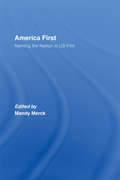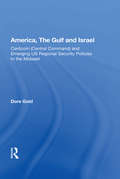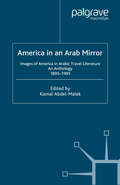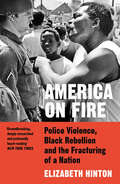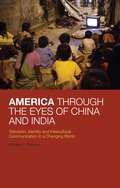- Table View
- List View
America First: Naming the Nation in US Film
by Mandy MerckAt a time when the expanded projection of US political, military, economic and cultural power draws intensified global concern, understanding how that country understands itself seems more important than ever. This collection of new critical essays tackles this old problem in a new way, by examining some of the hundreds of US films that announce themselves as titularly 'American'. From early travelogues to contemporary comedies, national nomination has been an abiding characteristic of American motion pictures, heading the work of Porter, Guy-Blaché, DeMille, Capra, Sternberg, Vidor, Minnelli and Mankiewicz. More recently, George Lucas, Paul Schrader, John Landis and Edward James Olmos have made their own contributions to Hollywood’s Americana. What does this national branding signify? Which versions of Americanism are valorized, and which marginalized or excluded? Out of which social and historical contexts do they emerge, and for and by whom are they constructed? Edited by Mandy Merck, the collection contains detailed analyses of such films as The Vanishing American, American Madness, An American in Paris, American Graffiti, American Gigolo, American Pie and many more.
America, The Gulf, And Israel: Centcom (central Command) And Emerging U.s. Regional Security Policies In The Middle East
by Dare GoldThis book evaluates whether the military preparations made by US in the aftermath of Central Command's (CENTCOM) establishment, represent the kind of change in America's military relationship with the Middle East. It also evaluates the implications of the creation of CENTCOM for US-Israel relations.
America, The Gulf, And Israel: Centcom (central Command) And Emerging U.s. Regional Security Policies In The Middle East
by Dare GoldThis book evaluates whether the military preparations made by US in the aftermath of Central Command's (CENTCOM) establishment, represent the kind of change in America's military relationship with the Middle East. It also evaluates the implications of the creation of CENTCOM for US-Israel relations.
America Imagined: Explaining the United States in Nineteenth-Century Europe and Latin America
by Axel Körner Adam I. SmithWhy has "America" - that is, the United States of America - become so much more than simply a place in the imagination of so many people around the world? In both Europe and Latin America, the United States has often been a site of multiple possible futures, a screen onto which could be projected utopian dreams and dystopian nightmares. Whether castigated as a threat to civilized order or championed as a promise of earthly paradise, America has invariably been treated as a cipher for modernity. It has functioned as an inescapable reference point for both European and Latin American societies, not only as a model of social and political organization - one to reject as much one to emulate - but also as the prime example of a society emerging from a dramatic diversity of cultural and social backgrounds.
America in An Arab Mirror: Images of America in Arabic Travel Literature: An Anthology
by K. Abdel-MalekThis distinguished anthology presents for the first time in English travel essays by Arabic writers who have visited America in the second half of the century. The view of America which emerges from these accounts is at once fascinating and illuminating, but never monolithic. The writers hail from a variety of viewpoints, regions, and backgrounds, so their descriptions of America differently engage and revise Arab pre-conceptions of Americans and the West. The country figures as everything from the unchanging Other, the very antithesis of the Arab self, to the seductive female, to the Other who is both praiseworthy and reprehensible.
America in the British Imagination: 1945 to the Present
by J. LyonsHow was American culture disseminated into Britain? Why did many British citizens embrace American customs? And what picture did they form of American society and politics? This engaging and wide-ranging history explores these and other questions about the U.S.'s cultural and political influence on British society in the post-World War II period.
America Is Not Post-Racial: Xenophobia, Islamophobia, Racism, and the 44th President
by Algernon AustinThis book is the first in-depth examination of the 25 million Americans with the most intense hatred of President Obama—arguably the most Republican-friendly of recent Democratic presidents—and what the mindsets of these "Obama Haters" teach us about race and ethnicity in America today.Despite the fact that President Obama was raised by a white mother and white grandparents, and has two degrees from Ivy League universities, he has still been subject to intense racial hatred from a large number of Americans. Even after Obama's presidency, the "Obama Haters"—and their xenophobia, Islamophobia, and racism—will continue to shape American politics. America is certainly not post-racial, argues author Algernon Austin, PhD, a noted sociologist and author on racial issues who consults on race, politics, and economics in Washington, DC. In this book, he uses the Obama Haters as an appropriate jumping-off point to consider what strategies might begin to reduce racial animosity in the United States—a real concern, considering that demographic trends are likely to exacerbate and escalate race-based hatred in our society.Austin sets the stage for the discussion by establishing that President Obama is hardly liberal in the eyes of liberal political activists, raising the question of why Obama is so intensely hated by some conservatives. He then compares the views of the Obama Haters—estimated to be some 25 million strong—with conservatives, moderates, and liberals who are not Obama Haters. The author shows how the Obama Haters are distinctly more xenophobic, Islamophobic, and racist than political conservatives who are not Obama Haters, underscoring the fact that the Obama Haters are motivated by more than just conservatism.
America Is Not Post-Racial: Xenophobia, Islamophobia, Racism, and the 44th President
by Algernon AustinThis book is the first in-depth examination of the 25 million Americans with the most intense hatred of President Obama—arguably the most Republican-friendly of recent Democratic presidents—and what the mindsets of these "Obama Haters" teach us about race and ethnicity in America today.Despite the fact that President Obama was raised by a white mother and white grandparents, and has two degrees from Ivy League universities, he has still been subject to intense racial hatred from a large number of Americans. Even after Obama's presidency, the "Obama Haters"—and their xenophobia, Islamophobia, and racism—will continue to shape American politics. America is certainly not post-racial, argues author Algernon Austin, PhD, a noted sociologist and author on racial issues who consults on race, politics, and economics in Washington, DC. In this book, he uses the Obama Haters as an appropriate jumping-off point to consider what strategies might begin to reduce racial animosity in the United States—a real concern, considering that demographic trends are likely to exacerbate and escalate race-based hatred in our society.Austin sets the stage for the discussion by establishing that President Obama is hardly liberal in the eyes of liberal political activists, raising the question of why Obama is so intensely hated by some conservatives. He then compares the views of the Obama Haters—estimated to be some 25 million strong—with conservatives, moderates, and liberals who are not Obama Haters. The author shows how the Obama Haters are distinctly more xenophobic, Islamophobic, and racist than political conservatives who are not Obama Haters, underscoring the fact that the Obama Haters are motivated by more than just conservatism.
America Observed: On an International Anthropology of the United States
by Virginia R. Dominguez and Jasmin HabibThere is surprisingly little fieldwork done on the United States by anthropologists from abroad. America Observed fills that gap by bringing into greater focus empirical as well as theoretical implications of this phenomenon. Edited by Virginia Dominguez and Jasmin Habib, the essays collected here offer a critique of such an absence, exploring its likely reasons while also illustrating the advantages of studying fieldwork-based anthropological projects conducted by colleagues from outside the U.S. This volume contains an introduction written by the editors and fieldwork-based essays written by Helena Wulff, Jasmin Habib, Limor Darash, Ulf Hannerz, and Moshe Shokeid, and reflections on the broad issue written by Geoffrey White, Keiko Ikeda, and Jane Desmond. Suitable for introductory and mid-level anthropology courses, America Observed will also be useful for American Studies courses both in the U.S. and elsewhere.
America on Fire: The Untold History Of Police Violence And Black Rebellion Since The 1960s
by Elizabeth HintonA radical reckoning with the racial inequality of America’s past and present, by one of the leading scholars of policing and mass incarceration in the US
America on the Edge: Henry Giroux on Politics, Culture, and Education
by H. GirouxHenry Giroux's latest work is a compelling collection of new and classic essays. Key topics such as education and democracy, terrorism and security, and media and youth culture are critiqued in Giroux's signature style. This is a fascinating collection for Giroux fans and educators alike.
America the Fair: Using Brain Science to Create a More Just Nation
by Dan MeeganWhat makes a person liberal or conservative? Why does the Democratic Party scare off so many possible supporters? When does our "injustice trigger" get pulled, and how can fairness overcome our human need to look for a zero-sum outcome to our political battles?Tapping into a pop culture zeitgeist linking Bugs Bunny, Taylor Swift, and John Belushi; through popular science and the human brain; to our political predilections, arguments, and distrusts, Daniel Meegan suggests that fairness and equality are key elements missing in today's society. Having crossed the border to take up residency in Canada, Meegan, an American citizen, has seen first-hand how people enjoy as rights what Americans view as privileges. Fascinated with this tension, he suggests in America the Fair that American liberals are just missing the point. If progressives want to win the vote, they need to change strategy completely and champion government benefits for everyone, not just those of lower income. If everyone has access to inexpensive quality health care, open and extensive parental leave, and free postsecondary education, then everyone will be happier and society will be fair. The Left will also overcome an argument of the Right that successfully, though incongruously, appeals to the middle- and upper-middle classes: that policies that help the economically disadvantaged are inherently bad for others. Making society fair and equal, Meegan argues, would strengthen the moral and political position of the Democratic Party and place it in a position to revive American civic life. Fairness, he writes, should be selfishly enjoyed by everyone.
America Through the Eyes of China and India: Television, Identity, and Intercultural Communication in a Changing World
by Edward D. ShermanAmerica has long exported its network and cable programming abroad, but with a changing world comes a changing dynamic. As global centers of power shift, and wealth becomes redistributed, and perhaps even re-centered, vast audiences which have never before had contact with American television will begin to gain access to the full wealth and abundance of American programming. The opening of new markets and new audiences, particularly within the growing superpowers of China and India, presents us with a novel situation. It is one thing for a show like The OC to be played in a nation like England, where the cultural and religious differences with the United States are not that profound, and quite another for it to air in a nation like India, where arranged marriages, the caste system, and pervasive poverty are still everyday realities.America Through the Eyes of China and India explores the dynamics of television, identity, and cultural communication, providing a new lens for encountering, interpreting, and judging American culture and the American identity.
America, Through the Spectacles of an Oriental Diplomat
by Tingfang WuAmerica has performed great service for the Orient and especially for China. If, however, the people of the latter country were asked to express their candid opinion on the matter, the verdict would not be altogether pleasant, but would be given with mixed feelings of gratitude and regret.
America Under Construction: Boundaries and Identities in Popular Culture (Routledge Library Editions: Cultural Studies)
by Kristi S. Long Matthew NadelhaftA variety of theoretical approaches to the study of culture have emphasised the significance of the creation, maintenance, and the transgression of boundaries to identities – be they social, cultural, national or personal. The essays collected in this book, first published in 1997, explore the creation of identities in American culture through analysis of the boundaries within and across which American identity is negotiated. The dissemination of cultural identity and the creation of national identity through this process has had a crucial impact on the shape of social life in post-war American culture. The contributors to this volume offer a variety of perspectives on this richly complicated process.
America Under Construction: Boundaries and Identities in Popular Culture (Routledge Library Editions: Cultural Studies)
by Kristi S. Long Matthew NadelhaftA variety of theoretical approaches to the study of culture have emphasised the significance of the creation, maintenance, and the transgression of boundaries to identities – be they social, cultural, national or personal. The essays collected in this book, first published in 1997, explore the creation of identities in American culture through analysis of the boundaries within and across which American identity is negotiated. The dissemination of cultural identity and the creation of national identity through this process has had a crucial impact on the shape of social life in post-war American culture. The contributors to this volume offer a variety of perspectives on this richly complicated process.
America, You Sexy Bitch: A Love Letter to Freedom
by Meghan McCain Michael Ian BlackShe is a single, twentysomething, gun-loving, Christian, Republican writer and blogger, the daughter of a Senator and 2008 Republican presidential nominee. He is a married, forty-year-old, gun-fearing, atheist, Democrat comedian, the son of a lesbian former Social Security employee. Meghan McCain and Michael Ian Black barely know each other. But they are about to change the way politics is discussed in America.Or at least the way politics are discussed in their crappy RV. In America, You Sexy Bitch, Meghan and Michael embark on a balls-out, cross-country tour starting in California, the heart of liberal America, and ending in the state of Connecticut, the home of blue-blood Wall Street billionaires. Along the way, they visit such cultural touchstones as Graceland and Branson, party in Las Vegas and New Orleans, pretend to be Mormon in Salt Lake City (only for a second), and go to a mosque in Dearborn, Michigan. They tour the nation&’s capital; they fire semiautomatic weapons. But mostly Meghan McCain and Michael Ian Black talk to each other: about their differences, their similarities, and how American politics has gotten so divided.
America, You Sexy Bitch: A Love Letter to Freedom
by Meghan McCain Michael Ian BlackShe is a single, twentysomething, gun-loving, Christian, Republican writer and blogger, the daughter of a Senator and 2008 Republican presidential nominee. He is a married, forty-year-old, gun-fearing, atheist, Democrat comedian, the son of a lesbian former Social Security employee. Meghan McCain and Michael Ian Black barely know each other. But they are about to change the way politics is discussed in America.Or at least the way politics are discussed in their crappy RV. In America, You Sexy Bitch, Meghan and Michael embark on a balls-out, cross-country tour starting in California, the heart of liberal America, and ending in the state of Connecticut, the home of blue-blood Wall Street billionaires. Along the way, they visit such cultural touchstones as Graceland and Branson, party in Las Vegas and New Orleans, pretend to be Mormon in Salt Lake City (only for a second), and go to a mosque in Dearborn, Michigan. They tour the nation&’s capital; they fire semiautomatic weapons. But mostly Meghan McCain and Michael Ian Black talk to each other: about their differences, their similarities, and how American politics has gotten so divided.
American Afterlives: Reinventing Death in the Twenty-First Century
by Shannon Lee DawdyA mesmerizing trip across America to investigate the changing face of death in contemporary lifeDeath in the United States is undergoing a quiet revolution. You can have your body frozen, dissected, composted, dissolved, or tanned. Your family can incorporate your remains into jewelry, shotgun shells, paperweights, and artwork. Cremations have more than doubled, and DIY home funerals and green burials are on the rise. American Afterlives is Shannon Lee Dawdy’s lyrical and compassionate account of changing death practices in America as people face their own mortality and search for a different kind of afterlife.As an anthropologist and archaeologist, Dawdy knows that how a society treats its dead yields powerful clues about its beliefs and values. As someone who has experienced loss herself, she knows there is no way to tell this story without also reexamining her own views about death and dying. In this meditative and gently humorous book, Dawdy embarks on a transformative journey across the United States, talking to funeral directors, death-care entrepreneurs, designers, cemetery owners, death doulas, and ordinary people from all walks of life. What she discovers is that, by reinventing death, Americans are reworking their ideas about personhood, ritual, and connection across generations. She also confronts the seeming contradiction that American death is becoming at the same time more materialistic and more spiritual.Written in conjunction with a documentary film project, American Afterlives features images by cinematographer Daniel Zox that provide their own testament to our rapidly changing attitudes toward death and the afterlife.
American Allegory: Lindy Hop and the Racial Imagination
by Black Hawk Hancock“Perhaps,” wrote Ralph Ellison more than seventy years ago, “the zoot suit contains profound political meaning; perhaps the symmetrical frenzy of the Lindy-hop conceals clues to great potential power.” As Ellison noted then, many of our most mundane cultural forms are larger and more important than they appear, taking on great significance and an unexpected depth of meaning. What he saw in the power of the Lindy Hop—the dance that Life magazine once billed as “America’s True National Folk Dance”—would spread from black America to make a lasting impression on white America and offer us a truly compelling means of understanding our culture. But with what hidden implications? In American Allegory, Black Hawk Hancock offers an embedded and embodied ethnography that situates dance within a larger Chicago landscape of segregated social practices. Delving into two Chicago dance worlds, the Lindy and Steppin’, Hancock uses a combination of participant-observation and interviews to bring to the surface the racial tension that surrounds white use of black cultural forms. Focusing on new forms of appropriation in an era of multiculturalism, Hancock underscores the institutionalization of racial disparities and offers wonderful insights into the intersection of race and culture in America.
American Allegory: Lindy Hop and the Racial Imagination
by Black Hawk Hancock“Perhaps,” wrote Ralph Ellison more than seventy years ago, “the zoot suit contains profound political meaning; perhaps the symmetrical frenzy of the Lindy-hop conceals clues to great potential power.” As Ellison noted then, many of our most mundane cultural forms are larger and more important than they appear, taking on great significance and an unexpected depth of meaning. What he saw in the power of the Lindy Hop—the dance that Life magazine once billed as “America’s True National Folk Dance”—would spread from black America to make a lasting impression on white America and offer us a truly compelling means of understanding our culture. But with what hidden implications? In American Allegory, Black Hawk Hancock offers an embedded and embodied ethnography that situates dance within a larger Chicago landscape of segregated social practices. Delving into two Chicago dance worlds, the Lindy and Steppin’, Hancock uses a combination of participant-observation and interviews to bring to the surface the racial tension that surrounds white use of black cultural forms. Focusing on new forms of appropriation in an era of multiculturalism, Hancock underscores the institutionalization of racial disparities and offers wonderful insights into the intersection of race and culture in America.
American Allegory: Lindy Hop and the Racial Imagination
by Black Hawk Hancock“Perhaps,” wrote Ralph Ellison more than seventy years ago, “the zoot suit contains profound political meaning; perhaps the symmetrical frenzy of the Lindy-hop conceals clues to great potential power.” As Ellison noted then, many of our most mundane cultural forms are larger and more important than they appear, taking on great significance and an unexpected depth of meaning. What he saw in the power of the Lindy Hop—the dance that Life magazine once billed as “America’s True National Folk Dance”—would spread from black America to make a lasting impression on white America and offer us a truly compelling means of understanding our culture. But with what hidden implications? In American Allegory, Black Hawk Hancock offers an embedded and embodied ethnography that situates dance within a larger Chicago landscape of segregated social practices. Delving into two Chicago dance worlds, the Lindy and Steppin’, Hancock uses a combination of participant-observation and interviews to bring to the surface the racial tension that surrounds white use of black cultural forms. Focusing on new forms of appropriation in an era of multiculturalism, Hancock underscores the institutionalization of racial disparities and offers wonderful insights into the intersection of race and culture in America.
American Allegory: Lindy Hop and the Racial Imagination
by Black Hawk Hancock“Perhaps,” wrote Ralph Ellison more than seventy years ago, “the zoot suit contains profound political meaning; perhaps the symmetrical frenzy of the Lindy-hop conceals clues to great potential power.” As Ellison noted then, many of our most mundane cultural forms are larger and more important than they appear, taking on great significance and an unexpected depth of meaning. What he saw in the power of the Lindy Hop—the dance that Life magazine once billed as “America’s True National Folk Dance”—would spread from black America to make a lasting impression on white America and offer us a truly compelling means of understanding our culture. But with what hidden implications? In American Allegory, Black Hawk Hancock offers an embedded and embodied ethnography that situates dance within a larger Chicago landscape of segregated social practices. Delving into two Chicago dance worlds, the Lindy and Steppin’, Hancock uses a combination of participant-observation and interviews to bring to the surface the racial tension that surrounds white use of black cultural forms. Focusing on new forms of appropriation in an era of multiculturalism, Hancock underscores the institutionalization of racial disparities and offers wonderful insights into the intersection of race and culture in America.
American Allegory: Lindy Hop and the Racial Imagination
by Black Hawk Hancock“Perhaps,” wrote Ralph Ellison more than seventy years ago, “the zoot suit contains profound political meaning; perhaps the symmetrical frenzy of the Lindy-hop conceals clues to great potential power.” As Ellison noted then, many of our most mundane cultural forms are larger and more important than they appear, taking on great significance and an unexpected depth of meaning. What he saw in the power of the Lindy Hop—the dance that Life magazine once billed as “America’s True National Folk Dance”—would spread from black America to make a lasting impression on white America and offer us a truly compelling means of understanding our culture. But with what hidden implications? In American Allegory, Black Hawk Hancock offers an embedded and embodied ethnography that situates dance within a larger Chicago landscape of segregated social practices. Delving into two Chicago dance worlds, the Lindy and Steppin’, Hancock uses a combination of participant-observation and interviews to bring to the surface the racial tension that surrounds white use of black cultural forms. Focusing on new forms of appropriation in an era of multiculturalism, Hancock underscores the institutionalization of racial disparities and offers wonderful insights into the intersection of race and culture in America.
American Allegory: Lindy Hop and the Racial Imagination
by Black Hawk Hancock“Perhaps,” wrote Ralph Ellison more than seventy years ago, “the zoot suit contains profound political meaning; perhaps the symmetrical frenzy of the Lindy-hop conceals clues to great potential power.” As Ellison noted then, many of our most mundane cultural forms are larger and more important than they appear, taking on great significance and an unexpected depth of meaning. What he saw in the power of the Lindy Hop—the dance that Life magazine once billed as “America’s True National Folk Dance”—would spread from black America to make a lasting impression on white America and offer us a truly compelling means of understanding our culture. But with what hidden implications? In American Allegory, Black Hawk Hancock offers an embedded and embodied ethnography that situates dance within a larger Chicago landscape of segregated social practices. Delving into two Chicago dance worlds, the Lindy and Steppin’, Hancock uses a combination of participant-observation and interviews to bring to the surface the racial tension that surrounds white use of black cultural forms. Focusing on new forms of appropriation in an era of multiculturalism, Hancock underscores the institutionalization of racial disparities and offers wonderful insights into the intersection of race and culture in America.
